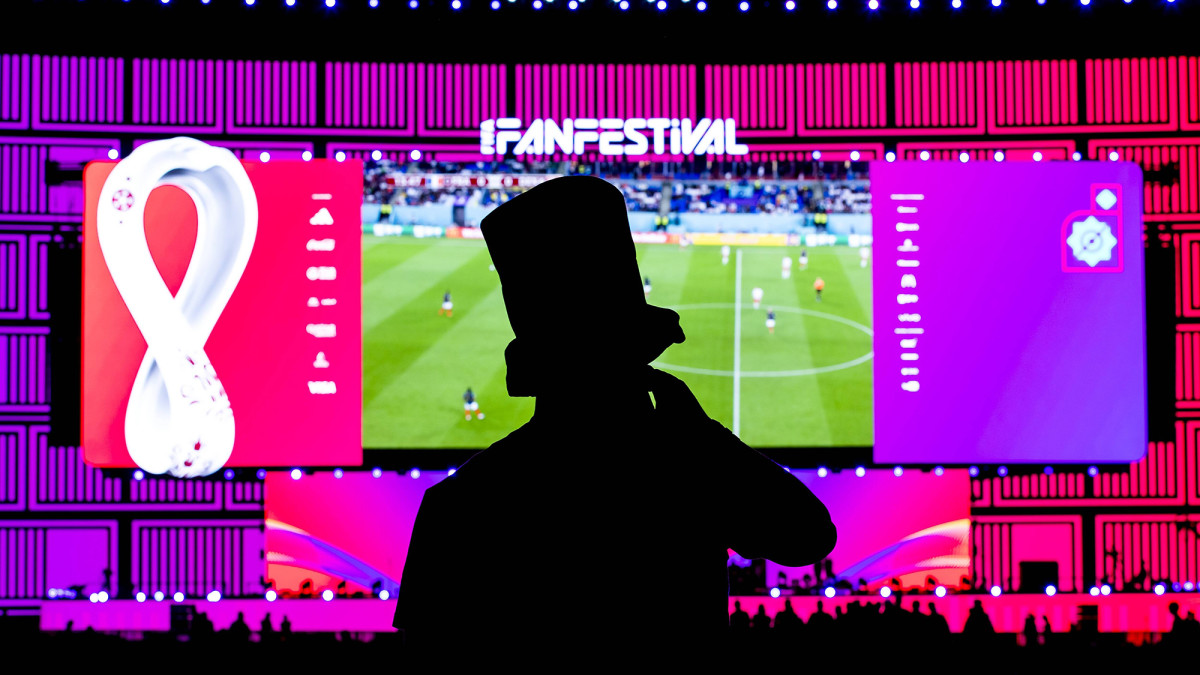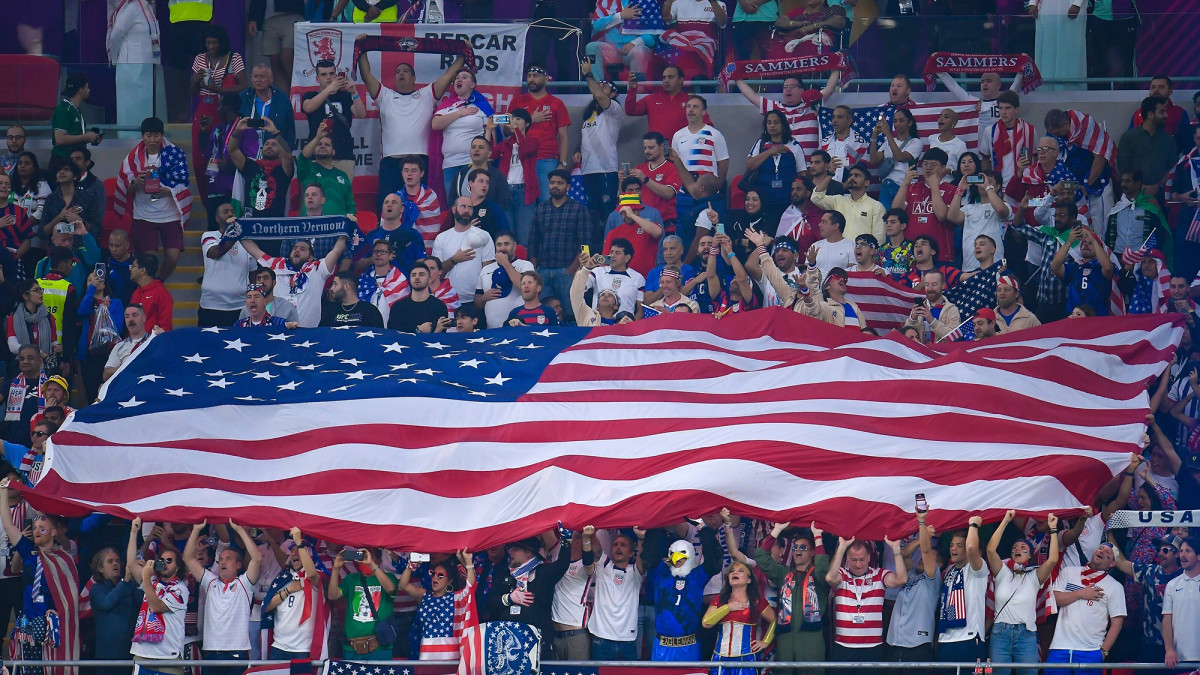To Skirt World Cup’s Stadium Alcohol Ban, One Fan Masked ABV With SPF
DOHA, Qatar — Here, at perhaps the most singular World Cup in soccer history, a hero walked among the masses. When not traveling the world, or hiking, kayaking, snowboarding, mountain biking or backpacking, this hero holds a normal job. He lives in the U.S., with his wife and their dog, a mutt with black lab vibes.
None of that relates to his heroism, except tangentially, because his spirit, hobbies and adventures long ago shaped a daring, try-anything soul. It all sets the stage for his trip here, to watch the U.S. men’s national team compete against Wales, England and Iran, while catching Argentina-Mexico, Spain-Germany, Germany-Japan, Portugal-Uruguay and Costa Rica-Japan. While thousands of Americans are doing the same thing, few, if any, dared to attempt what this hero, who we’ll call Teddy in exchange for candor and in the interest of his safety, managed to pull off.
Our hero, a late entrant into the field for Sportsperson of the Year, didn’t just find whiskey in Qatar.
He managed to smuggle it into stadiums.
Using a fake bottle.
Purchased on Amazon.
Delivered to his house.
Through the advice of a friend—and the help of a stranger.
From a suntan lotion company that doesn’t exist.
All while proving that, sometimes, heroes wear, not capes, but U.S. soccer T-shirts and Messi jerseys.

Teddy shares this info while still in Qatar, while also mentioning the scheme off-handedly, in a text message.
“I’ve also been bringing sunscreen bottle flasks of liquor into every match if that’s newsworthy,” it reads, followed by a crying emoji, “and had a wild experience trying to get the 30-foot American flag into the stadium.”
Wait. What? More on that later.
Anyway, Teddy sits on a barstool inside a pub in Doha. His friends pace and eat and drink nearby. He sips a Guinness, chasing the previous night’s hangover away. He’s wearing gray pants, that Messi jersey and a U.S. soccer hat, plus a full beard.
He agrees to tell the story of his lighthearted “smuggling” as long as it’s not shared, for those safety reasons, until after he leaves the country and cannot be detained or punished. The bottle is blue and looks exactly like real versions from various companies that actually sell sunscreen.
This is the bottle. It’s sold by a company named GoPong, in packs of two, for $9.99 on Amazon. The bottles are rectangular, made from plastic, and measure 3.5 inches by 2 inches by 8 inches. They come in different designs—SPF 15 or SPF 30—that the company says “make it easy to fool security so you can take your flask virtually anywhere.” They hold up to 16 ounces of booze, which the company bills as 10 (apparently generous!) shots—“perfect for a day out with friends, cruises, festivals, beach days, theme parks, and more.” They also include “free” funnels and liquor spouts for easy filling.
If you’re wondering how something like this happens, start with Teddy’s adventurous spirit, a bottomless well of curiosity. Two weeks before traveling to Doha from the U.S., he books a boat cruise at the harbor off downtown. While corresponding with the owner, whom Teddy will not name for similar safety concerns, he asks what any reasonable, red-blooded sports fan might want to know. Can his group get beer?
“I can go to the candy shop for you,” the man responds.
Teddy follows up.
“Can I order extra from you?”
“How much are you looking for? Like, within a reasonable amount.”
Teddy orders: cases of beer and hard seltzer, one bottle of Hendrick’s gin and one bottle of Jameson whiskey. They plan to drink the beer/seltzer on the boat, since both cases will be more difficult to transport. But they believe they can take the bottles with them.
Simultaneously, Teddy messages his fellow soccer travelers. He asks one to tell him what security is like on that traveler’s cruise ship, since that traveler will check in earlier than Teddy and his wife. The message that comes back alerts Teddy to the suntan lotion flasks. He orders them, two sets, four in total. Forty-eight hours later, they arrive via Amazon Prime delivery. What a world.
He flies. He boat cruises. He obtains. He funnels. He meets up with a friend from a fan group, and this friend gifts him a bottle of Clan McGregor scotch. By the time tournament officials ban alcohol at stadiums, 48 hours before the opener between Qatar and Ecuador, our hero has procured three bottles of booze—and just in time for the opening ceremony, no less.
Teddy and his wife head to the U.S. opener, against Wales, on Monday, Nov. 21, at Ahmed bin Ali Stadium in Al Rayyan. Teddy decides he wants to utilize what’s inside that sunscreen bottle in the lead-up, lest he get popped before watching Match 1. He finishes but brings the bottle into the stadium, as a test run of sorts. If the guards seize it, he reasons, he still has three more back at his shipping container hotel. They do not. He places the bottle in a bin next to the metal detectors. It sails through. “No big deal,” he says.
After discussing with other fans, Teddy forms a theory. At World Cup stadiums here, as a general rule, guards search bags thoroughly. But they do not search people without bags with nearly as much enthusiasm or concern. (For media entrances, this tracks.)
For Match 2, U.S. vs. England, held on a Friday night at Al Bayt Stadium in Al Khor, Teddy decides the test run is over. He “smuggles” in the real stuff. He discovers that karak tea—regional, sweet, ubiquitous—pairs well with whiskey from the suntan flask. He pours the booze in discreetly, or sips from the bottle while in the bathrooms.
But for this game, there is a problem. Security. They have issues. This bottle, they say, pointing at it. His heart drops, momentarily. Then the guard in front of him says the bottle is too big. It must be under the 100-millimeter limit. This is not a rule that Teddy has heard about before. He believes it must be made up at that moment or not enforced at others. He says, O.K., and thanks the guard for telling him there are storage facilities nearby that he can rent. He walks out but not toward the lockers. No, he heads to a different lane, only two over from the first one, and repeats the same process. Voilà, he’s inside.
Is this the most amazing thing that happens at the World Cup held in Qatar? Is it American hubris? Too risky, compared to the reward of a stronger buzz? Perhaps it’s all of those. Perhaps not. Heroism is the vote here. Teddy and his wife traveled halfway around the world, and they woke up with hangovers every morning, in a country where drinking is frowned upon and made intentionally difficult to partake in.
Oh, about that 30-foot flag. Teddy and his wife arrive for U.S.-Wales early. They march with the U.S. fans. But their friends have some of their tickets, and those friends are late to arrive. They’re late, because the ticketing system is down, which is indicative of the stadium experience here, where the concessions are often sold out of everything but Budweiser Zero and the Wi-Fi is like a choose-your-own-adventure book.

They see fellow U.S. fans carrying a giant, 30-by-20-foot flag. The carriers do have tickets in hand, and the U.S. fan who also obtained permits for a large drum he bangs throughout their marches, plans to take both in. Teddy and his wife volunteer to help, in the hope that once the group gets the flag in, officials won’t scan their tickets. Genius. All of it.
Since it’s early into the tournament, Day 2, security is befuddled. They keep asking the crew to fold and unfold the flag. They keep trying to gauge the size, to make sure it complies with the regulations listed on the permit. But their tape measurer is only about 26 feet long. This continues for a while: unfold, measure, fail at measuring, fold, repeat. They call over their boss, then his boss, then his boss’s boss. Teddy wonders whether they’re looking for rainbow signage, or another sign of protest.
After 45 minutes, the guards give up. They let the group in, and let the flag in, and they take only a cursory glance at an email screenshot of Teddy’s tickets. That it’s the same screenshot for both doesn’t matter. They’re actually escorted inside.
Few in the U.S.-supporter section sit in their assigned seats. Teddy and his wife settle two rows behind the flag as it unfurls during the national anthem. Maybe Teddy feels heroic at this moment. Perhaps he’s simply buzzed. Regardless, what a trip and what a World Cup. He’ll never look at a bottle of sunscreen the same way ever again.
